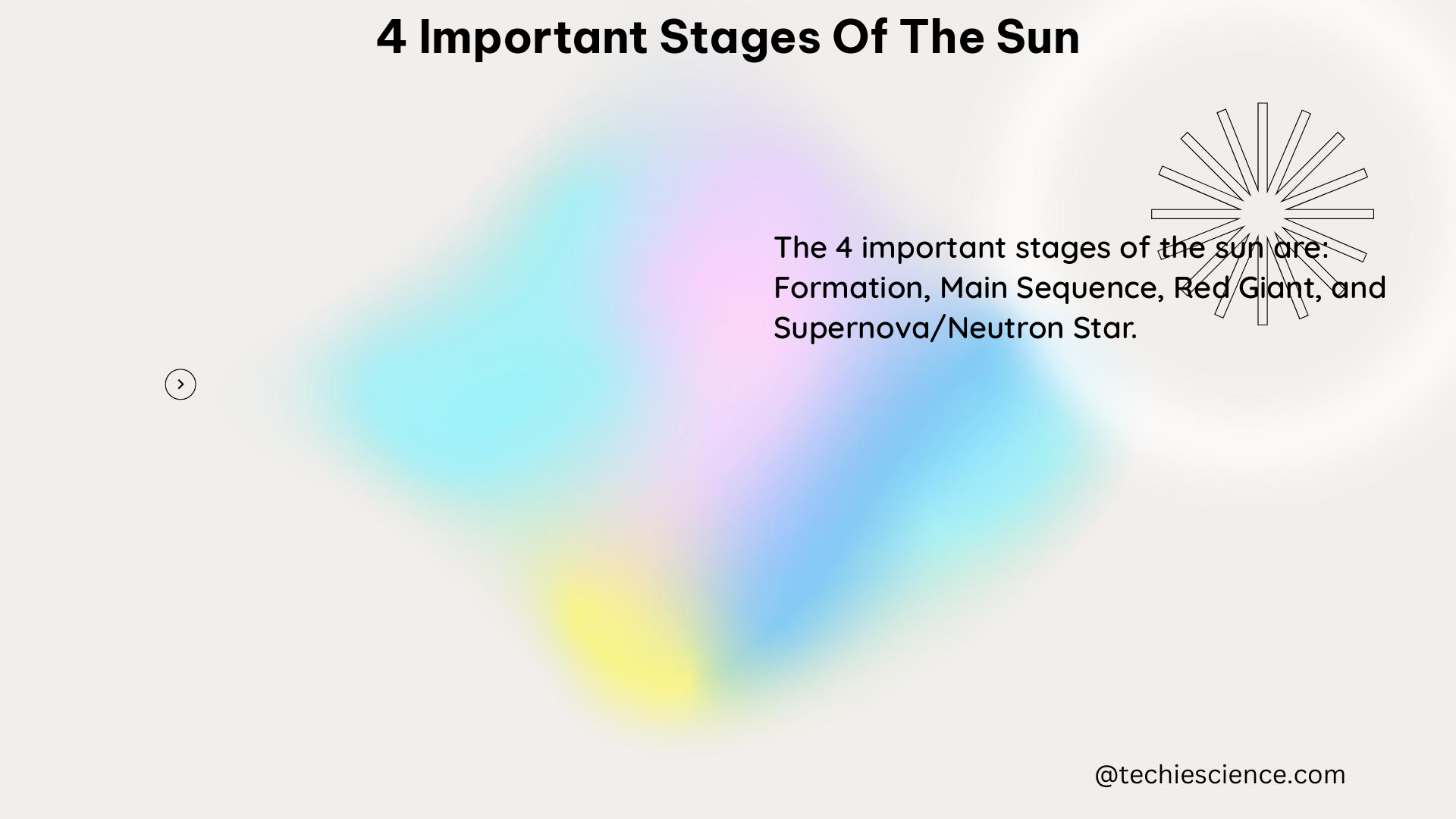The Sun, our nearest star, is a dynamic celestial body that undergoes a remarkable transformation throughout its life cycle. From its humble beginnings as a protostar to its eventual demise as a white dwarf, the Sun’s evolution is a captivating story that reveals the intricate workings of our solar system. In this comprehensive guide, we will delve into the four crucial stages of the Sun’s life cycle, exploring the intricate details, physics principles, and numerical examples that define each phase.
1. Protostar Stage
The Sun’s life cycle begins with the Protostar Stage, a period of approximately 100,000 years. During this stage, a massive cloud of gas and dust, known as a molecular cloud, collapses under its own gravitational pull, forming a dense, rotating core. This core is the embryonic stage of the Sun, where the temperature and pressure in the interior steadily increase, leading to the ignition of nuclear fusion at the core.
1.1. Gravitational Collapse
The process of gravitational collapse is governed by the Virial Theorem, which states that the total kinetic energy of a system is equal to half the negative of the total potential energy. As the molecular cloud contracts, the potential energy of the system decreases, and this energy is converted into kinetic energy, causing the temperature and pressure to rise.
The rate of gravitational collapse can be described by the Jeans Instability Criterion, which states that a cloud will collapse if its mass exceeds the Jeans mass, given by the formula:
$M_J = \left(\frac{5kT}{G\mu m_H}\right)^{3/2}\left(\frac{3}{4\pi\rho}\right)^{1/2}$
where $k$ is the Boltzmann constant, $T$ is the temperature, $G$ is the gravitational constant, $\mu$ is the mean molecular weight, $m_H$ is the mass of a hydrogen atom, and $\rho$ is the density of the cloud.
1.2. Nuclear Fusion Ignition
As the core of the protostar continues to contract, the temperature and pressure increase, eventually reaching the point where nuclear fusion can begin. This process is known as the ignition of nuclear fusion, and it marks the transition from the protostar stage to the main sequence stage.
The specific conditions required for nuclear fusion to occur in the Sun’s core are:
- Temperature: Approximately 15 million Kelvin
- Pressure: Approximately 340 billion Pascals
The primary nuclear fusion reaction that powers the Sun is the proton-proton chain reaction, which converts hydrogen into helium and releases vast amounts of energy in the process.
2. Main Sequence Stage

The Main Sequence Stage is the longest and most stable phase of the Sun’s life cycle, lasting approximately 4.57 billion years so far, with another 4.5 to 5.5 billion years remaining. During this stage, the Sun is in a state of hydrostatic equilibrium, where the outward pressure from nuclear fusion reactions in the core is balanced by the inward force of gravity.
2.1. Nuclear Fusion Reactions
The primary nuclear fusion reaction that powers the Sun during the Main Sequence Stage is the proton-proton chain reaction, which can be summarized as follows:
- $^1_1\text{H} + ^1_1\text{H} \rightarrow ^2_1\text{D} + e^+ + \nu_e$
- $^2_1\text{D} + ^1_1\text{H} \rightarrow ^3_2\text{He} + \gamma$
- $^3_2\text{He} + ^3_2\text{He} \rightarrow ^4_2\text{He} + 2^1_1\text{H}$
The energy released by these reactions is primarily in the form of gamma rays, which are then converted into other forms of energy, such as heat and light, through various processes within the Sun’s interior.
2.2. Luminosity and Spectral Class
During the Main Sequence Stage, the Sun’s luminosity, which is a measure of the total amount of energy it emits, will increase by approximately 30% over its lifespan. This increase in luminosity is due to the gradual increase in the core’s temperature and the corresponding increase in the rate of nuclear fusion reactions.
The Sun’s spectral class, which is a measure of its surface temperature, is currently G2V, indicating that it is a yellow dwarf star. As the Sun ages, its surface temperature will gradually increase, causing it to shift towards a higher spectral class, such as F or A.
2.3. Numerical Example
Suppose the Sun’s current luminosity is $3.828 \times 10^{26}$ watts, and its luminosity is expected to increase by 30% over its lifespan. Calculate the Sun’s luminosity at the end of its Main Sequence Stage.
Given:
– Current luminosity: $3.828 \times 10^{26}$ watts
– Increase in luminosity: 30%
To calculate the Sun’s luminosity at the end of its Main Sequence Stage, we can use the formula:
$L_\text{final} = L_\text{initial} \times (1 + 0.3)$
Substituting the values, we get:
$L_\text{final} = 3.828 \times 10^{26} \times (1 + 0.3) = 4.976 \times 10^{26}$ watts
Therefore, the Sun’s luminosity at the end of its Main Sequence Stage will be approximately $4.976 \times 10^{26}$ watts.
3. Red Giant Stage
After the Main Sequence Stage, the Sun will enter the Red Giant Stage, which is expected to last for approximately 1 billion years. During this stage, the Sun will undergo significant changes in its structure and behavior, as it begins to exhaust its supply of hydrogen fuel in the core.
3.1. Helium Flash and Core Contraction
As the Sun’s core runs out of hydrogen, the core will contract, and the outer layers will expand, causing the Sun to become a red giant. This expansion will cause the Sun’s radius to increase dramatically, encompassing the orbits of Mercury and Venus, and possibly even Earth.
During this stage, the Sun will undergo a helium flash, where the core temperature will suddenly increase, causing the fusion of helium into carbon and oxygen. This helium flash will be a brief but intense event, lasting only a few minutes.
3.2. Thermal Pulses and Planetary Nebula Formation
After the helium flash, the Sun will continue to lose mass through a series of thermal pulses, where the outer layers of the Sun will be ejected into space, forming a planetary nebula. This process will continue until the Sun’s core is left behind as a dense, hot object known as a white dwarf.
The specific characteristics of the Red Giant Stage can be summarized as follows:
- Expansion of the Sun’s radius to encompass the orbits of Mercury and Venus, and possibly Earth
- Helium flash, where the core temperature suddenly increases, causing the fusion of helium into carbon and oxygen
- Thermal pulses, where the Sun loses mass through the ejection of its outer layers, forming a planetary nebula
3.3. Numerical Example
Suppose the Sun’s current radius is 696,340 kilometers, and it is expected to expand to a radius of 215 million kilometers during the Red Giant Stage. Calculate the factor by which the Sun’s volume will increase.
Given:
– Current radius: 696,340 kilometers
– Expanded radius: 215 million kilometers
To calculate the factor by which the Sun’s volume will increase, we can use the formula for the volume of a sphere:
$V = \frac{4}{3}\pi r^3$
Substituting the values, we get:
$V_\text{initial} = \frac{4}{3}\pi (696,340)^3 = 1.412 \times 10^{18}$ cubic kilometers
$V_\text{final} = \frac{4}{3}\pi (215 \times 10^6)^3 = 5.233 \times 10^{21}$ cubic kilometers
The factor by which the Sun’s volume will increase is:
$\frac{V_\text{final}}{V_\text{initial}} = \frac{5.233 \times 10^{21}}{1.412 \times 10^{18}} = 3,706$
Therefore, the Sun’s volume will increase by a factor of approximately 3,706 during the Red Giant Stage.
4. White Dwarf Stage
The final stage of the Sun’s life cycle is the White Dwarf Stage, which is expected to last for trillions of years. During this stage, the Sun will cool and become a dense, compact object known as a white dwarf, primarily composed of carbon and oxygen.
4.1. Planetary Nebula Formation
As the Sun enters the Red Giant Stage, its outer layers will be ejected into space, forming a planetary nebula. This planetary nebula will gradually expand and dissipate, leaving behind the Sun’s dense core, which will become a white dwarf.
4.2. Degenerate Matter and Chandrasekhar Limit
The white dwarf stage is characterized by the presence of degenerate matter, where the electrons in the Sun’s core are packed so tightly that they become degenerate, meaning they occupy the lowest possible energy states. This degenerate matter is supported by the Pauli Exclusion Principle, which states that no two electrons can occupy the same quantum state.
The maximum mass that a white dwarf can have is known as the Chandrasekhar Limit, which is approximately 1.44 times the mass of the Sun. If a white dwarf exceeds this limit, it will undergo gravitational collapse and potentially become a neutron star or a black hole.
4.3. Luminosity and Cooling
As a white dwarf, the Sun will gradually lose its luminosity over time, eventually fading to black. The rate of cooling is determined by the white dwarf’s mass and composition, with more massive white dwarfs cooling more slowly than their less massive counterparts.
The specific characteristics of the White Dwarf Stage can be summarized as follows:
- Composition: Primarily carbon and oxygen
- Degenerate matter: Electrons packed tightly, supported by the Pauli Exclusion Principle
- Chandrasekhar Limit: Maximum mass of a white dwarf, approximately 1.44 times the mass of the Sun
- Gradual cooling and loss of luminosity over trillions of years
By understanding the four crucial stages of the Sun’s life cycle, we can gain a deeper appreciation for the dynamic and complex nature of our nearest star. This knowledge not only satisfies our curiosity about the universe but also provides valuable insights into the evolution of our solar system and the potential fate of our planet.
Reference:
- Kippenhahn, R., & Weigert, A. (1990). Stellar Structure and Evolution. Springer-Verlag.
- Shu, F. H. (1982). The Physical Universe: An Introduction to Astronomy. University Science Books.
- Ostlie, D. A., & Carroll, B. W. (2007). An Introduction to Modern Stellar Astrophysics. Pearson.
- Prialnik, D. (2000). An Introduction to the Theory of Stellar Structure and Evolution. Cambridge University Press.

Hi, I am Sanchari Chakraborty. I have done Master’s in Electronics.
I always like to explore new inventions in the field of Electronics.
I am an eager learner, currently invested in the field of Applied Optics and Photonics. I am also an active member of SPIE (International society for optics and photonics) and OSI(Optical Society of India). My articles are aimed at bringing quality science research topics to light in a simple yet informative way. Science has been evolving since time immemorial. So, I try my bit to tap into the evolution and present it to the readers.
Let’s connect through